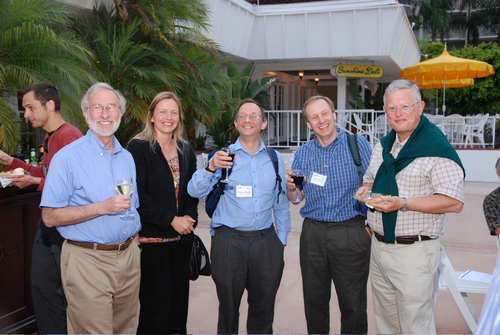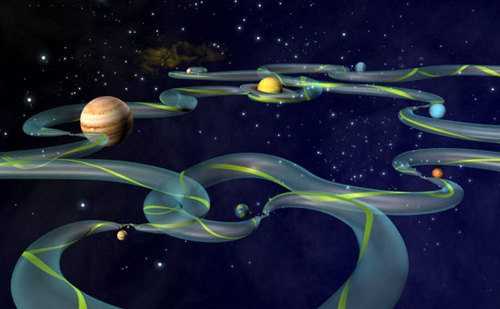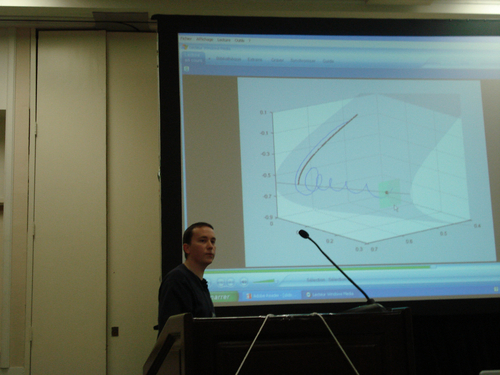Handling editor: Chad Topaz

Dynamical Systems at the 2008 SIAM Annual Meeting
Jeff Moehlis, Program Director of SIAG/DS and Department of Mechanical Engineering, University of California, Santa Barbara
The 2008 SIAM Annual Meeting was held from July 7-11 at the Town and Country
Resort Hotel and Convention Center in San Diego, California. Here are some
reflections on this conference that I have written to share with members of
SIAG/DS and the dynamical systems community at large.

Figure 1. Marty Golubitsky with Margot Gerritsen, Chris Budd, Andy Wathen, and
Russell Davies at the reception following Golubitsky's Past President's Address
on the WhyDoMath multimedia website [1]. Photo courtesy
of Carol Mehne.
Applications
The scientific program highlighted several application areas in which there
are opportunities for increased contributions from the dynamical systems
community. One such area is weather and climate modeling, which was featured
in Invited Presentations by Cecile Penland from the National Oceanic and
Atmospheric Administration and John Boyd from the University of Michigan.
Climate modeling and dynamical systems research have an interesting historical
relationship. For instance, the celebrated Lorenz equations, arguably the
prototypical chaotic system, came from Edward Lorenz's attempt to model
atmospheric dynamics. The study of these equations has contributed to a
framework for understanding sensitive dependence of initial conditions for
weather prediction and many other systems. As another example, stochastic
resonance was introduced by Roberto Benzi and coworkers as a mechanism for the
roughly periodic occurrence of Ice Ages.
In Cecile Penland's talk [2], she discussed El Nino, the temperature fluctuations
in the surface water of the Eastern Pacific Ocean that are associated with
extreme weather in the United States. Penland argued that the onset of El Nino
can be predicted reasonably well by an empirical model consisting of a
stochastically forced non-normal linear system that can display transient
growth. While it might seem surprising that such a relatively simple linear
model works so well, Penland points out that "El Nino is a combination of so
many highly chaotic nonlinear systems varying on a widely diverse range of
timescales that stochastic limit theorems (Khas'minskii 1966; Papanicolaou and
Kohler 1974) apply and they are indistinguishable from stochastic forcing.
That is, the system is so nonlinear that only the slowly-varying, linear
part of the system can be predicted on timescales larger than about a week."
Penland goes on to suggest that "What we really need are broader classes of
limit theorems that show under what conditions combinations of chaotic systems
converge to which classes of stochastic systems. Does synchronized chaos lead
to correlated additive noise at all, must it be a multiplicative noise in some
limiting dynamics, or what? Can the 'chaotic hypothesis' of Gallavotti and
Cohen be given a firm mathematical basis? Do we really need an attractor to be
Anasov, or Axiom A, to support Markov partitions? Is it possible to perturb
externally a system lying on a non-Anasov attractor so that Markov partitions
can be supported on the perturbed system? If so, how? If not, will an
approximation do? Can any of these structures converge to Lèvy processes?
Under what conditions?"
In John Boyd's talk [3], he explained that ensemble forecasting "is an attempt to
compute some dynamical systems measures from real forecasting models, such as
the Lyapunov exponent. The ensemble is seeded with singular vectors as
perturbations which represent the directions of fastest growth of
perturbations in the billion-dimensional phase space of the model." He also
highlighted that an important, but underappreciated, difficulty with weather
forecasting is initializing computer models to be consistent with the slow
manifold corresponding to the weather's evolution. This is an issue of
"compatibility conditions," which are relations between the governing partial
differential equations, boundary conditions, and initial conditions that need
to be satisfied to get well-behaved numerical results. After his talk, he
mentioned (personal communication) that the dynamical systems community might
be able to develop more rigorous techniques for identifying when, where, and
for how long atmospheric blocking (a stagnation of weather patterns) will
occur.
Of course, researchers in the dynamical systems community are already working
on these and related problems in climate modeling, and are making crucial
contributions. Nonetheless, it may be time for a stronger effort from our
community to address these important problems, especially considering growing
concerns about global warming. On this note, one of the highlighted themes of
the upcoming 2009 SIAM Conference on Applications of Dynamical Systems (at
Snowbird) [4] will be climate modeling, and Henk Dijkstra from Utrecht University [5]
will be giving an invited presentation on this subject.
The global climate affects us all. Another phenomenon that touches our
everyday lives was also mentioned frequently at the Annual Meeting: the
Internet. The scientific program included talks on subjects ranging from
search algorithms to the analysis of statistical properties of nodes and links
in the network that is the Internet. The Internet-related talks focused
heavily on network structure and not on dynamics. Nonetheless, the Internet is
a dynamical system, and as
stated by Jon Kleinberg from Cornell University [6], who gave an Invited
Presentation on social and information networks, "the dynamical systems
community has a number of powerful mathematical techniques at its disposal
that could contribute to this area." This work could include a consideration
of the dynamics of the spread of information through the Internet, the
dynamics of group and community structure on social sites (which has been
studied in the computer science community, but less from a mathematical
perspective) and how the Internet is affected by topological changes such as
the addition and subtraction of nodes and links.

Figure 2. Sketch of the interplanetary superhighway from Shane Ross' WhyDoMath
entry on invariant manifolds on the Why Do Math website
[1]. shown during Marty Golubitsky's past President's
Address. Artist: Cici Koenig (image obtained from images.google.com).
Why Do Math
Marty Golubitsky gave the Past President's Address (see Figure 1) on a multimedia
website [1] that he and others are developing to
highlight exciting contributions that applied mathematics and computational
scientists have made in science, society, and everyday life. This website
features articles aimed at the undergraduate freshman/sophomore level, and
strives to convey the excitement and importance of the research that our
broad community does. Several articles can be viewed on the development page
http://dev.whydomath.org. Two of these articles have a clear dynamical systems
flavor, namely one by Shane Ross on the interplanetary superhighway, shown in Figure 2
(related to invariant manifolds) and one by Brent Doiron and Eric Shea-Brown
on mathematical neuroscience. Golubitsky made a plea for help with this
important effort. If you have a mathematics success story (one that has
already come to fruition), are an excellent writer, have web skills, and/or
have suggestions for articles for the Reading Room on the WhyDoMath site,
contact [email protected].
SIAM Fellows
A major topic of discussion at the SIAM Business Meeting at the conference was
whether or not SIAM should institute a Fellows program [7]. Many readers may
already be familiar with the idea of "fellows" from other professional
societies. Various pros and cons regarding a Fellows Program have been
articulated, and should be carefully considered. Visit
http://fellows.siam.org
to find more information. In particular, the Fellows FAQ and The Proposal
links may be of particular interest. Voting on this issue is currently
underway.

Figure 3. Mathieu Desroches, a graduate student at the University Bristol,
discusses numerical computations of canards and mixed-mode oscillations for a
self-coupled FitzHugh-Nagumo system. Photo courtesy of Jeff Moehlis.
Final Thoughts
Other dynamical systems highlights at the meeting included (but were not
limited to) Bard Ermentrout's SIAG/DS-sponsored talk called "The Olfaction
Way" (a play on the title of the W.C. Fields movie "The Old Fashioned Way") as
well as minisymposia on neuroscience, device applications of
nonlinear dynamics, and computational techniques, shown in Figure 3. There was
also a successful
minisymposium on undergraduate dynamical systems research organized by Chad
Topaz and Andy Bernoff. In conclusion, the dynamical systems community was
well represented at the Annual Meeting, and that it is clear that we will have
plenty of interesting problems to think about in the immediate future.
References
| [1] |
|
Why Do Math, http://www.whydomath.org
and
http://dev.whydomath.org
|
| [2] |
Cecile Penland, http://www.cdc.noaa.gov/people/cecile.penland/
|
| [3] |
John Boyd, http://aoss.engin.umich.edu/people/jpboyd
|
| [4] |
SIAM Meeting on Applied Dynamical Systems, http://www.siam.org/meetings/ds09/, Snowbird Utah, 2009.
|
| [5] |
Henk Dijkstra, http://www.phys.uu.nl/~dijkstra/
|
| [6] |
Jon Kleiberg, http://www.cs.cornell.edu/home/kleinber/
|
| [7] |
SIAM Fellows, http://fellows.siam.org
|
| [8] |
A full list of talks is available at the SIAM Annual Meeting website, http://www.siam.org/meetings/an08/
|